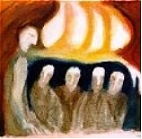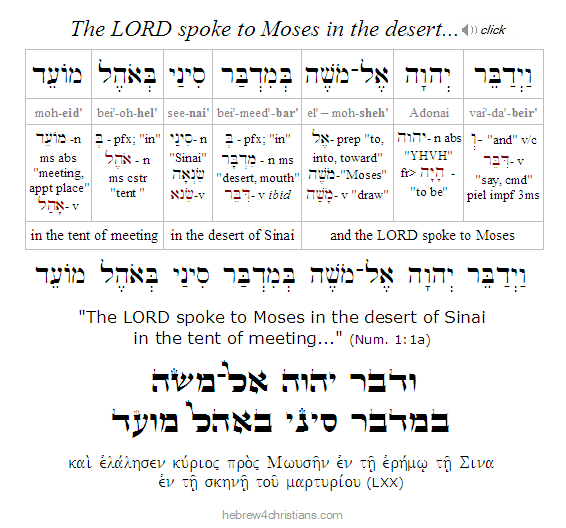|
|
 |
 |
|
Click on the Parashah name to read the summary:
|
 |
 |
|
Getting Ready for Shavuot...
|
 |
 |
|
We have a busy week ahead of us. First we honor Yom Yerushalayim ("Jerusalem Day)" that commemorates the prophetic reunification of Jerusalem and the Israeli control over the Old City. Second, we start reading the fourth book of the Torah, namely Sefer Bamidbar (ספר במדבר), or the "Book of Numbers." Finally, the month of Sivan begins Tuesday, May 27th at sundown, which heralds the conclusion of the 49 day countdown from the day following Passover (see Lev. 23:15-16). The first five days of the month anticipate the day the Torah was given to Israel at Sinai, namely, the sixth of Sivan (i.e., Shavuot), which comes exactly seven weeks (49 days) after the Exodus from Egypt.
In light of this, I hope to share some things related to both the Torah portion for this week, the significance of Jerusalem to us as followers of Yeshua, as well as the holiday of Shavuot (i.e., "Pentecost"), which occurs the following week (i.e., Sunday, June 1st after sundown). May the LORD show us grace as we study his Torah and review its significance as written upon our hearts in the Messiah (Jer. 31:31, Heb. 10:16, Jer. 32:40). Amen.
Upcoming Holiday Dates:
- Yom Yerushalayim - Sun. May 25th at sundown (and the following day)
- Chodesh Sivan - Tues. May 27th at sundown (and the following day)
- Shabbat Bamidbar - Fri. May 30th at sundown (and the following Saturday)
- Shavuot ("Weeks, Pentecost") - Sunday June 1st at sundown - Tues. June 3rd
|
 |
 |
 |
 |
 |
 |
 |
 |
|
Parashat Bamidbar
|
|
|
|
Torah Reading Overview...
|
|
|
|
Our Torah portion for this week, parashat Bamidbar (פרשת במדבר), begins the Book of Numbers (ספר במדבר), where the narrative begins precisely where the Book of Exodus left off, that is, with the glory of the LORD hovering over the Mishkan (Tabernacle) as the Israelites were stationed at Sinai (Exod. 40:38, Num. 1:1). On the first day of the thirteenth month following the Exodus from Egypt – exactly thirty days after the Tabernacle was first consecrated – God commanded Moses to take a census of all Israelite males over 20 years of age who would bear arms. Moses and the heads of each tribe recorded the results, with 603,550 men in all. This number did not include the Levites, however, since they were designated to take care of the Tabernacle during the journeys.
The LORD then gave instructions about how the Israelite camp was to be arranged. The Tabernacle would occupy the central location, with three clans of the Levites surrounding it on the north, south, and west (Moses and Aaron's tents were placed before the entrance on the east). The twelve other tribes were divided into four groups of three. All of the tents of the Israelites were to face the Tabernacle on every side. This camp formation was to be strictly maintained while traveling throughout the desert.
 |
Each tribe had its own prince (i.e., nassi: נשׂיא), its own flag (i.e., degel: דגל) whose color corresponded with the color of its respective stone in Aaron's breastplate (Exod. 28:15-21). For example, Judah's stone was a sky-blue carbuncle and therefore the color of his flag was like the color of the sky with a "fiery lion" embroidered upon it (see Gen. 49:9).
The portion ends with a census of the three sons of Levi (בני לוי), namely Gershon (גרשׁון), Kohath (קהת), and Merari (מררי). The Gershonites were to maintain the inner tent of the Mishkan and were to be located on the west side of the courtyard; the Kohathites were to maintain the furnishings of the Mishkan such (as the Ark of the Covenant, the Menorah, etc.) and were to be located on the south side of the courtyard; and the Merarites maintained the frames and pillars of the Mishkan and were located to the north of the courtyard. Finally, though the sons of Aaron were descendants of Kohath, they were set apart to serve as priests (i.e., kohanim: כהנים) and were located before gate into the Mishkan to the east.
|
|
|
Blessing before Torah Study:
|
|
|
|
 |
|
|
|
|
|
|
|
The Month of Revelation...
|
|
 |
 |
|

The third month of the Torah's calendar (as reckoned from the month of Nisan) is called Sivan (סיון), a 30-day lunar month which usually begins during late May or early June. In the Torah this month is simply called "the third month" (i.e., ha'chodesh ha-shlishi: החודש השלישי), though some time after the Babylonian Captivity it assumed its present name. Sivan is mentioned only once in the Jewish Scriptures, in the Book of Esther (Esther 8:9).
Since Sivan always has 30 full days, Rosh Chodesh Sivan (i.e., the celebration of the new month) is observed for only one day. The rabbis call the second day of Sivan is called "yom hameyuchat" (the "day of distinction"), since on this day the people agreed to accept the Torah, and upon thier ratification Moses instructed the people to prepare themselves to become "a kingdom of priests and a holy nation" (Exod. 19:6-8). In some circles this "day of distinction" is celebrated as a minor festival. On the third day of month the LORD instructed Moses to "set a boundary" (hagbalah) for the people around the mountain in preparation for the coming revelation to be given "three days later" (Exod. 19:9-15). These three days are called the "Three Days of Separation" (i.e., Sheloshet Yemei Hagbalah: שְׁלשֶׁת יְמֵי הַגְּבָּלָה) to prepare for the revelation on Sivan 6th: "Make yourselves ready by the third day" (Exod. 19:11,15). The Talmud comments: "Blessed be our God who has given a threefold Torah (Torah, Prophets, Writings) to a threefold nation (Kohanim, Levites, and Israelites) through one who was third (Moses, the third child after Aaron and Miriam) in the third month."
The first five days of the month of Sivan anticipate the day that the Torah was revealed to Israel at Sinai, namely, on the sixth of Sivan, a date which the rabbis later associated with the holiday of Shavuot ("Weeks" or "Pentecost"), which occured exactly seven weeks after the Exodus from Egypt. As mentioned in the Shavuot pages, on the night of Shavuot it is customary to stay up all night reading selections from the Torah until sunrise. This custom is called tikkun leil shavu'ot: תִּקּוּן לֵיל שָׁבוּעוֹת, "Rectification for Shavuot Night," and was instituted as a "remedy" for Israel's failure to be awake on the morning of the revelation (the midrash scolds the people who overslept on the morning of the revelation and needed to be roused to salute the King). Spiritually speaking, then, the month of Sivan represents the giving of the Torah to Israel (i.e., z'man mattan Toratenu: זְמַן מַתַּן תּוֹרָתֵינוּ), when the drama which began with the Exodus from Egypt culminated with the giving of the Torah. For Messianic believers, the month of Sivan also commemorates the giving of the Ruach Ha-Kodesh (Holy Spirit) to the followers of Yeshua after His ascension into heaven.
Rosh Chodesh Blessing:
יְהִי רָצוֹן מִלְּפָנֵיךָ יהוה אֱלהֵינוּ
וֵאלהֵי אֲבוֹתֵינוּ שֶׁתְּחַדֵּשׁ עָלֵינוּ חדֶשׁ טוֹב
בַּאֲדנֵינוּ יֵשׁוּעַ הַמָּשִׁיחַ אָמֵן
ye·hee · rah·tzon · meel·fah·ney'·kha · Adonai · E·loh·hey'·noo
vei·loh·hey · a·voh·tey'·noo · she·te·cha·deish · ah·ley'·noo · choh·desh tohv
ba'a·doh·ney'·noo · Ye·shoo'·a' · ha·mah·shee'·ach · ah·mein

"May it be Your will, LORD our God and God of our fathers,
that you renew for us a good month in our Lord Yeshua the Messiah. Amen."

Download Study Card
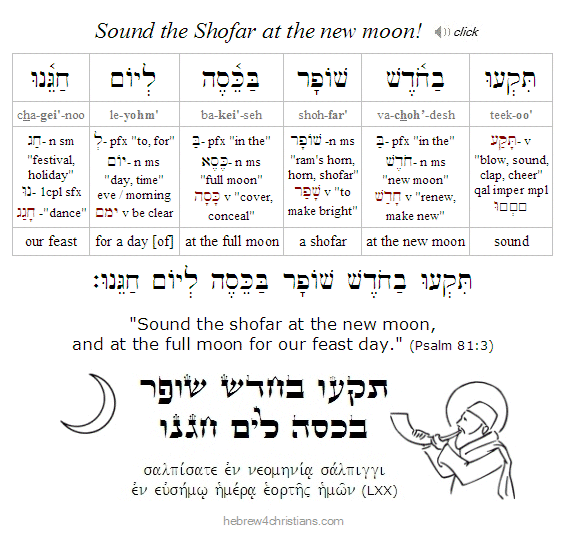
|
 |
 |
 |
|
 |
 |
|
|
|
|
|
The Importance of Jersualem...
|
|
|
|
In Israel, "Jerusalem Day" (i.e., Yom Yerushalayim: יום ירושלים) commemorates the re-unification of old city of Jerusalem on June 7th, 1967 during the Six Day War. In 1968 the Chief Rabbinate of Israel declared Iyyar 28 to be a minor holiday to thank God for answering the 2,000-year-old prayer of "Next Year in Jerusalem." On March 23, 1998, the Knesset passed the Jerusalem Day Law, making it a national holiday. This year, Iyyar 28 runs from Sunday, May 25th (after sundown) through the following day until sundown.
 |
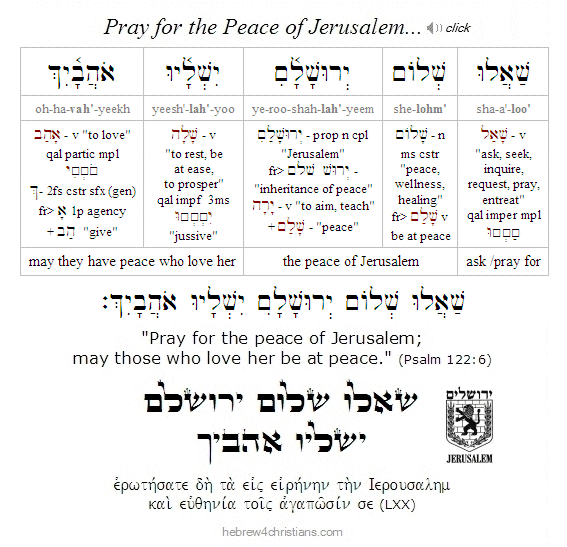 |
In the Scriptures, the word "Jerusalem" (ירושׁלם) occurs over 800 times, more than any other place name in the Bible. Friends, how can we forget Zion, "the city of the living God, the heavenly Jerusalem" (Heb. 12:22)? Is she not "our mother" (Gal. 4:26)? Are we not her citizens, indeed, her exiles in this age? As the psalmist said, "If I forget you, O Jerusalem, let my right hand forget its skill! Let my tongue stick to the roof of my mouth, if I do not remember you, if I do not set Jerusalem above my highest joy!" (Psalm 137:5-6). Of course we are instructed to "pray for the peace of Jerusalem" (Psalm 126:6), but we are further told to "badger" the LORD until he makes Zion "the praise of the earth" (Isa. 62:7).
|
|
|
 |
|
|
|
The Holiday of Shavuot...
|
|
 |
 |
|
Sunday, June 1st (at sundown) marks the end of the 49 days of counting the omer, and therefore the following day is the "Jubilee" of Shavuot (i.e., "Weeks" or "Pentecost"). Recall that the Torah instructed (Lev. 23:15-16) that we count from the day following Passover (i.e., Nisan 16) for exactly seven weeks, until Sivan 5 (i.e., from April 10th until June 7th this year). On the 50th day (i.e., Sivan 6), a special celebration was to be observed. This annual "countdown period" recalls both the time from the Passover until the revelation at Sinai, and the advent of the Holy Spirit among Yeshua's disciples in Jerusalem (Acts 2:1-4).
|
 |
 |
|
According to the sages, the festival of Shavuot marks the culmination of the experience of redemption, sometimes called Atzeret Pesach (עֲצֶרֶת פֶּסַח), or the "conclusion" of Passover. Since the Exodus from Egypt was intended to lead to the revelation given at Sinai, the goal of Passover was the giving of the Torah to the Jewish people.
|
|
|
 |
 |
|
In other words, the LORD took the Jews out of Egypt so that they would be His own treasured people, holy and separated from the pagan cultures around them, living in the light of great revelation. Indeed, all of the holidays of the biblical calendar are connected with this event, including the fall festivals of Rosh Hashanah, Yom Kippur and Sukkot.
During this time, it is customary for young adults to recommit themselves to Talmud Torah (the study of Torah) and to renew their decision to live as faithful Jews. In addition to formal "confirmation ceremonies" observed at synagogues, some other Shavuot customs include decorating the home and synagogue with greenery, eating dairy foods and sweets (as samples of the "milk and honey" of the promised land), and staying up the entire night of Shavuot to read selections from the Torah and from the Talmud (this custom is called tikkun leil shavu'ot: תִּקּוּן לֵיל שָׁבוּעוֹת, "Rectification for Shavuot Night"). For the Messianic Jew, Shavuot is the time of celebrating the birth of kallat Mashiach - the Bride of the Messiah (or the new covenant assembly), since the Ruach HaKodesh (Holy Spirit) was poured out to the believers in Yeshua during this festival (Acts 2:1-4).
|
 |
|
|
|
|
|
 |
 |
|
Note: For additional insight into the portions of Torah read during the festival of Shavuot, please click here (day 1) and here (day 2). To read a brief Shavuot meditation, please see the heart of Torah. For further information about Shavuot, see the Site Updates pages.
|
|
 |
 |
|
Jewish tradition teaches be'chol dor vador - that in every generation each person should consider him or herself as having personally received the Torah at Sinai. The climax of the Shavuot morning service is the recitation of the famous Akdamut poem followed by the reading of the Ten Commandments, when all the congregation stands to "relive" the experience at Sinai. A second Torah scroll is then taken out of the ark and the portion is read (Num. 28:26-31) that describes the sacrificial offerings made at the Temple during Shavuot, and the Haftarah (Ezek. 1:1-28; 3:12) concerns the amazing revelation of God in the form of the Throne/Chariot.
The Scroll of Ruth (מגילת רות) - a beautiful story about God's redemptive love - is traditionally read on the second day of Shavuot. As the Goel (kinsman-redeemer), Boaz was a wealthy man of the tribe of Judah (Bethlehem) who married a Gentile bride. Boaz's name means "in Him is strength," a picture of the Yeshua the Messiah, his greater Descendant, who also redeemed for himself a bride from among the nations. Among traditional Jews, the Book of Ruth is is read since the events recounted took place during the time of the spring harvest (linking it to the agricultural aspect of Shavuot), and Ruth is a picture of willing acceptance of a Jewish lifestyle (linking it to the events of Sinai).
The holiday of Shavuot is one of the shelosh regalim (three major "pilgrimage festivals") commanded in the Torah (Exod. 23:14-17; Deut. 16:16) and therefore it reveals profound spiritual truth for followers of Yeshua (Luke 24:44; 2 Tim. 3:16). God did not want us to miss the significance of this holiday, since it expresses the freedom and truth of the New Covenant of Zion. From my family to you: Shavuot Sameach - "Happy Shavuot!" May this be a time of renewal and great joy in your lives....
|
 |
 |
 |
 |
 |
 |
 |
|
 |
 |
 |
 |
 |
 |
 |
|
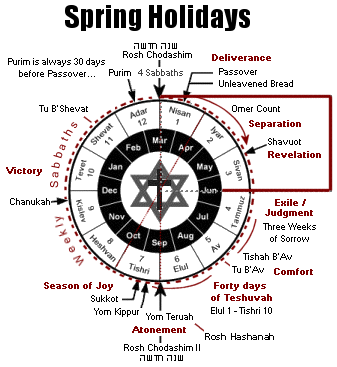 |
|
|
|
Some terms:
|
|
|
|
- Parashah is the weekly Scripture portion taken from the Torah. Each parashah is given a name and is usually referred to as "parashat - name" (e.g., parashat Noach). For more information about weekly readings, click here.
- Aliyot refer to a smaller sections of the weekly parashah that are assigned to people of the congregation for public reading during the Torah Reading service. In most congregations it is customary for the person "called up" to recite a blessing for the Torah before and after the assigned section is recited by the cantor. For Shabbat services, there are seven aliyot (and a concluding portion called a maftir). The person who is called to make aliyah is referred to as an oleh (olah, if female).
- Maftir refers to the last Torah aliyah of the Torah chanting service (normally a brief repetition of the 7th aliyah, though on holidays the Maftir portion usually focuses on the Holiday as described in the Torah). The person who recites the Maftir blessing also recites the blessing over the Haftarah portion.
- Haftarah refers to an additional portion from the Nevi'im (Prophets) read after the weekly Torah portion. The person who made the maftir blessing also recites the blessing for the Haftarah, and may even read the Haftarah before the congregation.
- Brit Chadashah refers to New Testament readings which are added to the traditional Torah Reading cycle. Often blessings over the Brit Chadashah are recited before and after the readings.
- Mei Ketuvim refers to a portion read from the Ketuvim, or writings in the Tanakh. Readings from the Ketuvim are usually reserved for Jewish holidays at the synagogue.
- Perek Yomi Tehillim refers to the daily portion of psalms (mizmorim) recited so that the entire book of Psalms (Tehillim) is read through in a month. For a schedule, of daily Psalm readings, click here.
- Gelilah refers to the tying up and covering the Sefer Torah (Torah Scroll) as an honor in the synagogue.
- Divrei Torah ("words of Torah") refers to a commentary, a sermon, or devotional on the Torah portion of the week.
|
|
|
|
 |
|
|
|
Related Topics:
|
|
|
|
|
|
|
<< Return
|
|
|
|
Hebrew for Christians
Copyright © John J. Parsons
All rights reserved.
|
|
|
|
 |
|
|
|
|
|
|






